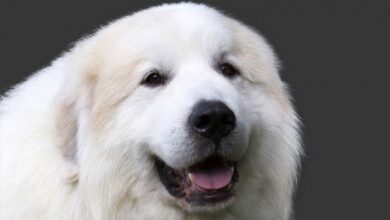Australian Shepherd
It is not fully known why it is called “Aussie” – it is difficult to define its close relationship with this country. Its story has a lot of holes and question marks in general. Nevertheless, it made a huge career in the world of ranchers, farmers and shepherds. It is able to touch a hard heart with its loyalty and tenderness, but also to delight the most demanding working people. Loving and tough, cheerful and intelligent. The Australian Shepherd has features that many dog lovers dream about.
Classification FCI
- Group 1 Sheepdogs and Cattle dogs (except Swiss Cattle dogs)
- Section 1 Sheepdogs
- Without working trial
- Other names: Aussie, Little blue dog
- Origin: United States

The history of the breed’s origin
This breed was previously referred to by a variety of terms that had nothing to do with Australia. Spanish Shepherd, Pastor Dog, Bob-Tail, New Mexican Shepherd, California Shepherd, and Austrian Shepherd – these are just a few examples.
There is a view among many cynologists that the Aussie is of Basque or Spanish origin. It is likely that it already served as a herding dog there. Over the years, Iberian shepherds began to migrate to the US West Coast with their pets, after living in Australia for a while, where shepherd dogs were needed for sheep herds brought from Europe.

It is known for certain that the breed developed in the west of North America at the turn of the 19th and 20th centuries. We also know that these dogs turned out to be great shepherds in the Rocky Mountains. They showed their endurance and devotion. So, in Colorado, the breeding of dogs began and they relatively quickly found their fans in western California. Even then, they were considered almost legendary shepherds.
The fact is that Aussies have a very strong herding instinct and intelligence that makes them great helpers to farmers to this day. However, we do not know much about their past, although there are many theories about it. However, there are many indications that – despite the name – the breed has more in common with the US than with Australia.

Characteristic
Appearance
Aussie is a medium-sized dog, lively, muscular and very agile. The ears are triangular in shape and set high. Full of alertness, almond eyes can be brown, amber or blue. There are also color combinations of irises. The coat can be wavy or straight, its structure – hard.
Thanks to its structure, the hair plays a protective role in cold or rainy weather. The undercoat (the underside of the fur) becomes abundant in winter and thinner in spring and summer. A collar is formed around the neck, pants are visible on the rear legs and fringes on the front legs.

Within the breed, we distinguish the following colors:
- Black tri, with copper points, white markings
- Red (liver) with or without copper points or white markings on the face
- Blue merle (a mottled patchwork of gray and black) with or without copper points or white markings on the face
- Red merle
- Chocolate
- Black
- Chocolate marbled (merle / speckled)
In each color variant, there are sometimes white accents (e.g. on the collar, chest, legs or head).

Merle – disastrous gen
The merle coat is a mixture of colors: the base is black, brown or red. There are light patches on the base, most often gray, red or blue. The eye color can be frosty blue, with amber or dark brown spots added.
The merle color is the result of a certain gene. It occurs in some breeds of dogs, and the crossing of two individuals with it is strongly inadvisable. Puppies born of such parents are deaf and often blind.

Lethal white – “deadly white”
Lethal white syndrome
This term comes from the so-called Lethal white syndrome, which occurs in horses, mainly the American Paint Horses. Currently, the term lethal white refers to dogs with the characteristics of the so-called double merle (the bitch and the dog had the merle gene, which they passed on to their offspring). Double merle owners have an almost completely white coat, there are also problems with eyes, eyesight and hearing.
Lethal white is found in many breeds but is most common in Australian Shepherds. The term “lethal whiteness” can be a bit misleading, however, since double merle does not cause death, but “only” causes sight and hearing disabilities. Puppies born with double merle are often killed by breeders because they are of poor quality (whatever it sounds like) and will not be bought by potential customers.

Temperament – a demanding dog
It has the characteristics typical of herding dogs: energy, physical endurance, protective instinct and distance towards strangers. It is also characterized by great loyalty to its owners, a need to play and learn new skills. The owner should stimulate him physically and mentally through long walks, jogging or dog sports.
Due to its physical and mental build, the Aussie works well on farms and ranches as a watchman. When it sees an alien figure in the area, it alarms about it by barking. However, a healthy Aussie is not prone to obsessive barking.
It learns new skills quickly, it even makes it fun for it. It is tired of the boredom, neglect and indifference of its owners. Frustrated, it may begin to organize “lawlessness” to consume large stores of energy. She loves human company and likes large families. It is sometimes referred to as a “turnip” because it always wants to be close to its beloved people. It often chooses one person with whom it forms a strong bond. However, since its ancestors worked across the vast expanses of the US, the Aussie needs a lot of space.

Detailed data / dimensions (size)
Australian Shepherd
- Average height at the withers:
- males: 51-58 cm (20-23 in)
- females: 46-53 cm (18 – 21 in)
- Weight:
- males: 18–32 kg (40–70 lb)
- females: 16–29 kg (35–65 lb)
- Lifespan: 13-15 years

Australian Shepherd – interesting facts
- These dogs require an average of 2-3 hours a day for play, exercise and general attention from the owner.
- The Aussie is ranked the 17th most popular dog breed in the US.
- The Aussie is often chosen to work with unusual farm animals such as geese, ducks and rabbits.
- The most common health problems within the breed are eyesight (conjunctivitis, cataracts) and hip joints (dysplasia).



















